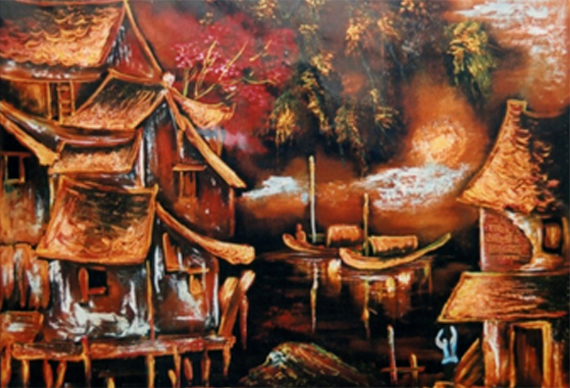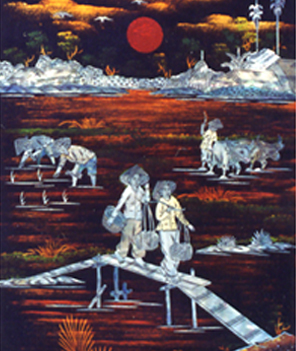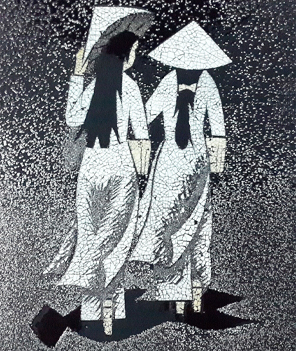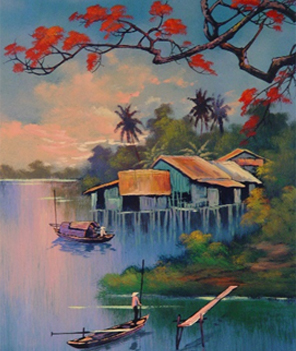0789 185 589
phuongnamlac@gmail.com
THE INTRODUCTION OF THE VIETNAMESE LACQUERWARE
As a traditional fine art that goes back many years in Vietnam though no one knows for sure how many, Vietnamese lacquerware was handed down from generation to generation as a family secret until the first half of the 20th century (From 1925) when the renovation of the field led by excellent artists of the Indochina College of Fine Arts in Hanoi made the occupation popular not only in Vietnam but also all over the world.
Since then, the legend of Vietnamese lacquerware has come true. Many generations of lacquer artists have gradually enhanced the quality of Vietnamese lacquerware in the last seventy years: discovering new materials to add to the palette of colored lacquers, the method of mixing various colors, the process of creating the lacquerware, and particularly the technique of rubbing the lacquerware in water. Vietnamese lacquer art, however, is extremely time-consuming and labor-intensive; Vietnamese lacquerware is the hard work of many people: Lacquer artists, lacquer painters, and many workers who shed their sweat to the fullest spending over 100 days through 20 stages to create the Vietnamese lacquerware. As a result, every Vietnamese lacquerware bears the feelings of its creator: flexibility, complexity, and variety. The lacquerware seems to carry something that appears now disappears passionately, ardently, and magically. Many artists always say that the first time they saw the lacquer, it was its blackness that impressed them. It is the black of the universe holding all things and having incredible depth to it.
THE RECENT HISTORY, AND DEVELOPMENT OF THE VIETNAMESE LACQUER ART:
Nguyen Gia Tri, a Vietnamese lacquer artist virtuoso whose gorgeous works and impeccable sense of Vietnamese lacquer art won him the adoration of critics and crowds alike, was one of the pioneers.
Some of his lacquer artworks have been placed at solemn palaces living up to his reputation. The "Paradise" was put at the French Governor’s Palace in Hanoi before 1945. After 1945, the premises became the Presidential Palace and the famous lacquer painting has been situated there up to now. The "Spring Garden of the South, Centre, and North" (2m x 5,4m) was purchased by Ho Chi Minh City People's Committee to display at the Beauty Art Museum and this was the first time the authority spent such a record amount of money to buy a painting of Vietnamese artist: USD 100,000.
After the North was freed from French Colonialism in 1954, the senior lacquer artists went hand in hand with younger generations to bring the lacquer art up to a new grade and this was the time Vietnamese lacquer art sowed scores of successful paintings: "Bamboo"(Tran Dinh Tho), "Missing North-Western Evening" (Phan Ke An), "Reading" (Huynh Van Gam), “Passing Monkey Bridge" (Nguyen Van Hien), "Dawn at the grain field" (Nguyen Duc Hung), “Happiness" (Phan Gia Giang), etc... Most of the lacquer artworks have been displayed at the Vietnam Beauty Art Museum and were printed in Vietnam Lacquer Art Selection & published in 1977.
Besides, with many expositions abroad in the years 1956, and 1959, Vietnamese Lacquer Art was highly appreciated by critics and crowds as well as received good reviews in international Media.
While in the South before 1930 Vietnamese Lacquer Art was developed in Hue, Hoi An, Thu Dau Mot, Saigon Gia Dinh, and then, the French opened a school in Bien Hoa in the early 20th century to train a generation of lacquer painters aiming at meeting the high demand of the French market.

THE RENOVATION OF THE VIETNAMESE LACQUERWARE TECHNIQUE
Vietnamese lacquer art is extremely labor-intensive and time-consuming work. Every Vietnamese lacquerware usually goes through 20 stages not less than 100 days regardless if it is a large picture or just some small lacquerware pieces such as bowls or even coasters. There are 3 kinds of lacquerware: Mother-of-pearl, eggshell, painting, or any combination of these three.
First of all, however, we must select the suitable wood for every Vietnamese lacquerware: rose, cherry, or walnut wood for the furniture, screens, or jewelry boxes, ebony for statues; jackfruit wood for boxes, bowls, plates, and plywood for paintings. The wood then will be filled with a layer of natural lacquer which gradually seeps through to a cord of wood to make it harder and against any rotting by insects.
Besides, the raw lacquerware is also covered with a piece of gauze to prevent any crack or curving shape. Still, the raw material will bear 5 more layers of lacquer to hide the gauze and reach the necessary thickness. However, in between each layer of lacquer, the lacquer artist must wait until the lacquer gets dried and then rub it in water. The work will be repeated many times (sometimes up to 15 lacquer layers or more) until the lacquerware becomes smooth.)
Lacquer - Sources, Extraction, And Mixtures
The lacquer is a resin of the lacquer tree planted mostly in the Northern Vietnamese province of Phu Tho and has its scientific name: Rhus Succedanea. First extracted from a tree, the lacquer is white, condensed like milk then turns brown in the air and gradually becomes black when dried. Once hardened, the lacquer forms a lustrous, durable surface impervious to moisture, insects, and oxidation, making it ideal for preserving materials, such as wood and bamboo. The lacquer tree is also planted in the highland Vietnamese province of Lam Dong to supply the Southern market. From the natural lacquer, the lacquer artist will mix it with some mineral pigments to produce other kinds of lacquer: cockroach-colored lacquer, lacquer for sticking mother-of-pearl and eggshell, and lacquer for covering the top.
Mother-Of-Pearls Lacquerware
A variety of mother of pearls from the sea will be cut into different shapes with a thickness of about 2 mm each. The Vietnamese lacquerware artist then draws the designs over its surface and uses a coping saw to cut them into small pieces, which are eventually gathered and inlaid on the lacquerware.
Once inlaid, the mother-of-pearl design is a bit thicker than the surface of the wood. Hence, the lacquerware artist will apply a mixture of natural lacquer and plaster to build up the lacquerware surface step by step until it reaches the same level.
The mother-of-pearls, however, in their natural state have no details like the eyes, the nose of a person or animal, and other small things in the design. The lacquerware artist will use a pointed knife to carve the details, making the design more lively and attractive. Still, each Vietnamese lacquerware will be filled with about 10 layers of lacquer, and in between each layer, the lacquerware artist will wait until it is dry and then do the rubbing in water. The work will finish when the lacquerware reaches the highest smoothness. Last but not least is the lacquerware-polishing stage.

Lacquer Ware Polishing
Duck eggshell is specially applied in Vietnamese lacquerware and it is the shell of the ducks already hatched because of its thickness and whiteness. The eggshell will be stuck onto the lacquerware following the ready-made design then filled with ten layers of lacquer and rubbed in water.
The duck eggshell in its natural state is white then the next step, the Vietnamese lacquerware artist will color the eggshell by using the mineral pigments mixed with some chemical dyes to reach the highest smoothness, then covered with many layers of lacquer and again rubbed in water in between each layer. The final stage is lacquerware polishing.

Painting Lacquerware
The Vietnamese lacquerware artist will paint directly on the ready–treated wood using mineral pigments mixed with lacquer. Like the two other kinds of Vietnamese lacquerware, painted lacquerware will be filled with many layers of lacquer and rubbed in water until it becomes smooth. Lacquerware polishing is the final stage.

Lacquer Ware Polishing
Lacquerware polishing plays a significant role in the Vietnamese lacquerware creation process. After many times rubbing in water, the lacquerware is smooth but not shiny. Therefore, the lacquerware artist applies the palm together with abrasives as diverse as charcoal and iron oxide to polish the lacquerware. Polishing hardened lacquer with such materials & techniques finally brings the lacquerware surface to a high gloss.
The lacquerware, after being polished, is like a mirror as you can catch a reflection of yourself in it when you look at it. Each Vietnamese lacquerware bears all the hard work of many Vietnamese lacquerware artists for not less than 100 days.
Lacquerware Care
Natural beauty combined with durability is the main characteristic of each Vietnamese lacquerware. The lacquerware, if with proper care, will retain its beauty for many years. Although each Vietnamese lacquerware is unique, below are some general precautions to help you get the most use out of your lacquerware.
1. Keep your lacquerware out of direct sunlight and away from extreme heat. Ultraviolet light and extreme heat will fade the lacquerware surface and result in tiny cracks. Once damaged, deterioration can happen, and your lacquerware's beauty and life span will be reduced.
2. Avoid using chemicals to clean your lacquerware. Instead, try to use a dry or damp cloth to wipe away dust and moisture gently.
3. When washing your lacquerware, use mild soap and warm water. Rinse and dry immediately after cleaning. Do not clean with hot water or try not to soak your lacquerware for too long.
ENJOY YOUR UNIQUELY HANDCRAFTED VIETNAMESE LACQUERWARE!
 19 Vo Van Tan St, Vo Thi Sau Ward, Dist 3, HCM City, Vietnam
19 Vo Van Tan St, Vo Thi Sau Ward, Dist 3, HCM City, Vietnam
 0789 185 589 - 0932 503 639 - 0917 673 341
0789 185 589 - 0932 503 639 - 0917 673 341
 phuongnamlac@gmail.com
phuongnamlac@gmail.com
phuongnamlac@hotmail.com
 www.phuongnamart.com
www.phuongnamart.com
Hotline
Hotline
